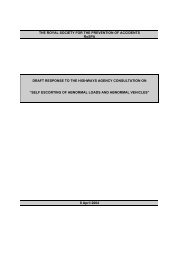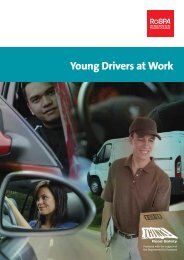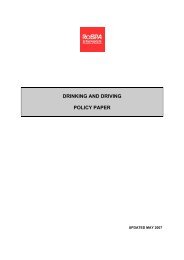Prof Andrew Tolmie, Professor of Psychology and Human ... - RoSPA
Prof Andrew Tolmie, Professor of Psychology and Human ... - RoSPA
Prof Andrew Tolmie, Professor of Psychology and Human ... - RoSPA
You also want an ePaper? Increase the reach of your titles
YUMPU automatically turns print PDFs into web optimized ePapers that Google loves.
considered, providing them with explicit reasons why these mattered, <strong>and</strong> then retiring into<br />
the background to allow the group to discuss these ideas.<br />
Peer tutoring in adolescent road safety education?<br />
Although the trainers involved in all the research described above were adults (usually<br />
parents who needed no more than basic guidance in how to run training sessions), past<br />
work (e.g. Foot, Shute, Morgan & Barron, 1990) has established that older children are<br />
capable <strong>of</strong> taking on the same role with minimal difficulty. Indeed, they may have some<br />
potential advantage over adults, in as much as learners are less likely to simply defer to the<br />
expert view under these conditions, engaging with it <strong>and</strong> even challenging it to some extent<br />
instead, thus forcing a better quality <strong>of</strong> debate. Peer trainers are also more likely to ‘speak<br />
the same language’ as trainees, facilitating communication <strong>and</strong> debate still further.<br />
One implication <strong>of</strong> this is that peer tutoring using the trainer-small group combination may<br />
have an important potential value in adolescent road safety education. Recent research<br />
(<strong>Tolmie</strong>, Thomson, O’Connor, Foot, Karagiannidou, Banks, O’Donnell & Sarvary, 2006)<br />
has established that better pedestrian skills tend to lead to safer road-crossing behaviour on<br />
the part <strong>of</strong> young adolescents. However, although these skills are in general reasonably<br />
well-developed by 12 years <strong>of</strong> age, individual variability is high <strong>and</strong> greater consolidation<br />
would therefore be helpful. One substantial obstacle to this, though, is a growing trend<br />
amongst adolescents as they get older towards peer-reinforced carelessness, <strong>and</strong> a tendency<br />
to regard road safety issues as childish. Under these circumstances, adult tutoring is likely<br />
to be counterproductive since it would merely tend to confirm this impression <strong>of</strong><br />
childishness.<br />
A peer tutoring system involving, for instance, Year 9 pupils working as trainers with Year<br />
7 pupils would get round this difficulty, <strong>and</strong> would be likely to have further crucial<br />
advantages. Firstly, it would serve to promote <strong>and</strong> consolidate enhanced skills amongst the<br />
Year 7 pupils, who would take the message more seriously since it emanated from their<br />
‘cooler’ seniors. Secondly, it would re-focus the attention <strong>of</strong> Year 9 pupils on road safety<br />
issues, consolidate their existing skills, <strong>and</strong> promote a greater awareness <strong>of</strong> gaps which the<br />
effort to train others would help correct. It would also serve to counteract any sense <strong>of</strong><br />
childishness surrounding road safety issues which they might feel, since they would be in<br />
the senior, <strong>and</strong> responsible role, something which is known to impact positively on<br />
adolescents’ behaviour in this context (Lupton & Bayley, 2001). Thirdly, if one <strong>of</strong> the<br />
National Road Safety Congress 2007 Page 4 <strong>of</strong> 8

















